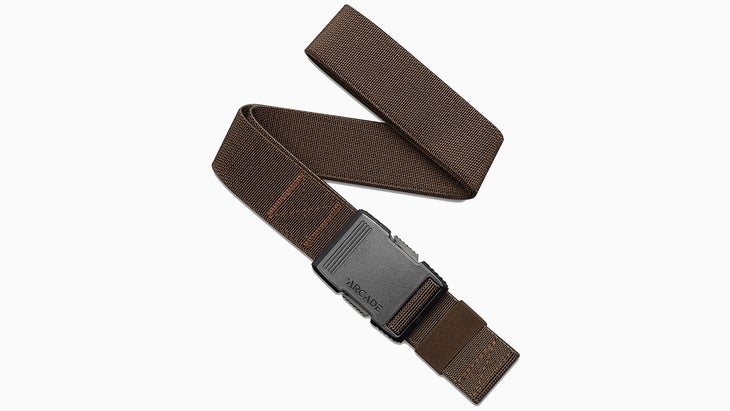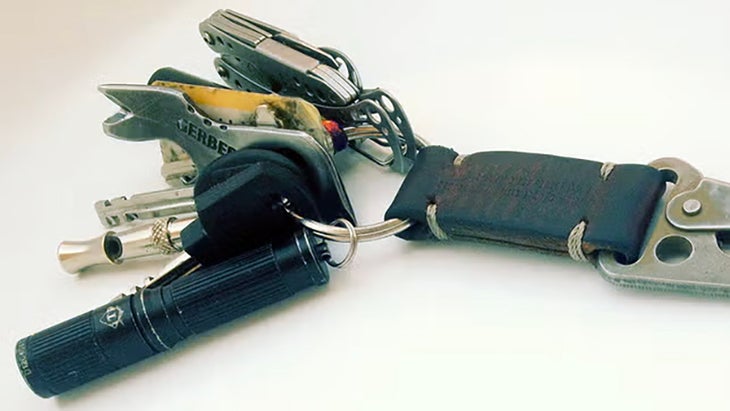
It’s fun to imagine an apocalyptic scenario, and purchase the kind of neon green tomahawk you think will help you defeat zombie hoards. (Spoiler alert: it won’t.) But when it comes to preparing for more likely situations—say, an emergency while traveling—many of us are guilty of being caught flat-footed.
I get it. With severely limited space in carry-on luggage, plus the very real possibility of never seeing anything you check ever again, it’s easy to focus on the destinations on the other side. But travel often involves as much frustration as it does excitement. Based on over three decades of regular air travel both here in the United States and abroad, here are some simple changes I’ve made to what I pack that help eliminate or address common problems.
Make the Most of Multiple-Use Clothing
Clothing is absolutely ket. For example, when packing for a backpacking trip, the key to saving weight is to only bring items that serve multiple purposes. A puffy jacket can keep you warm and be your pillow. Duct tape can fix torn clothing and prevent blisters. With space so limited inside a carry-on, adopting that same approach works just as well while traveling. Clothing will take up the most space in your luggage by far, so getting the most out of your clothes is key to travel preparedness.
Wool is a super-fabric that helps keep you cool when it’s hot, and warm when it’s cold. Versus cotton, it dries much faster and compared to synthetics, it can last through many more unwashed wears before getting stinky. Merino is softer next to the skin than other varieties.
Switching cotton socks and t-shirts to merino items is an obvious trick. Less so is the button down dress shirt. By packing one of those made from lightweight wool, not only do you get a single item that will better resist wrinkles and smells versus your standard cotton items, but also something that when paired with that merino t-shirt, quickly becomes a performance mid-layer, adding insulation and moisture wicking to your layering system. Last summer, I wore a Taylor Stitch CPO shirt ($168) to walk around Paris sightseeing all day, then headed to Frenchie for the five-course tasting menu. I was comfortable and looked good throughout.
Another versatile item is the shacket. Heavier than a button down and lighter than most jackets, a good shaket (or jac-shirt) can be left unbuttoned to dress up a tee, or snapped closed with the collar turned up to serve as a warm mid-layer. Depending on the time of year and destination, I choose from items made from polyester fleece, wool, or down, and am rewarded with a layer that transitions easily from mountain to city, or outdoor activity to indoor environment. For more casual environments, I practically live in a black Sitka Snowcrest LS fleece jac-shirt ($129).
The final piece in any layering system is the shell. These seal out wind and precipitation, and trap warm air in your other layers, keeping you toasty and dry. And while really hard, persistent rain demands the reliability of a waterproof-breathable membrane, high levels of activity, and changing conditions work better without one. Because waxed-cotton canvas can be adapted to increasing needs for waterproofness with the application of more wax, because it breathes better than any membrane, and because it can be dressed up or down to suit scenarios ranging from airport terminals to fancy restaurants, I’ve transitioned to wax cotton shells for travel. Fjallraven’s Raven jacket ($250) features a classic style that looks good in pretty much any environment while providing ample weather protection.
On the upper half of your body, there are very few conditions that layering a merino t-shirt, a wool button down, a jac-shirt, and a waxed cotton shell will not be able to handle.

Carry Cords Compatible with Common Outlets, Plus Extra Power
Traveling between countries with different plug designs can be a nightmare. Because of that, many planes, hotel rooms, and offices have added USB-A compatibility to their power outlets. But few devices still use that design. Before you fly, purchasing cables that start with USB-A, and end in whatever style of port your devices require will simplify your packing and guarantee you’ll be able to plug in no matter where you find yourself.
Pro Tip: Even if you find yourself in a hotel or office without USB-A wall outlets, televisions, monitors, and many other devices will include one. Look behind those before declaring defeat.
But as devices have moved away from USB-A, so have power bricks. To solve that problem, I recently upgraded to Anker Power Bank. That packs a wall charger, two USB-C outlets, one USB-A outlet, and a 10,000mAh battery all into one $70, cigarette pack-sized, multiple use device.
Dose Your Liquids and Don’t Forget the First-Aid Kit
Grab this assortment of travel-sized, color-coded, leak-proof Nalgene bottles, and take the time to measure out the amount of potions and medications you need for the duration of your trip. Write out the contents on the bottle using a Sharpie.
In addition to everyday necessities (Egyptian Magic and toothpaste), I like to bring some ibuprofen, Pepto Bismol, peppermint Dr. Bronners, a prescription antibiotic (ask your doctor), and a travel-size pack of skin-friendly wet wipes. For a first-aid kit, I carry a small role of duct tape, a tube of 0.5-ounce tube of Neosporin, and a pack of 0.17-ounce Krazy Glue singles.
Properly Light Your Way at Night
Phone flashlights are all well and good—until it’s dark out and you need to see something further away than right in front of you. Plus, phone flashlights aren’t hands-free by nature and they suck battery when you’re trying to conserve the last few bars of precious juice. This is going to be a radical suggestion, I know, but carry a dedicated flashlight.
In my carry-on, I keep an Olight Clip Pro ($32). That gives me the easy ability to switch from a 130-yard spot beam to a very bright 500-lumen flood, to a night vision-preserving red light that’s capable of flashing for visibility, all with an intuitive, rotating, physical knob. The tiny 2.25-inch package can then be clipped to a backpack strap, shirt pocket, or hat should you need to go hands free, or inside a tent or to a curtain should you need area illumination.
I’ve used mine to add extra evening visibility to a crappy rental bike and to hike nighttime trails. With a battery life that lasts 144 hours on its lowest brightness and an hour and 21 minutes on full blast, I just charge it before I fly somewhere.
Save Your Documents
My wife had her passport stolen out of her purse during our last visit to London, while her purse was hanging on the back of my chair at a pub so I could guard it. Because we snapped a picture of that way back when it was renewed, then emailed a copy of that image to both of our email accounts (complete with an easily searchable subject line), it didn’t cause us more than an hour of inconvenience, since we had proof of ID ready to go when we swung by the embassy for a replacement. Do the same with your driver’s license, and any visas or other travel documents. Should the worst happen, and your phone be lost, stolen, or disabled, you can log into your email from another person’s phone, or at an Internet cafe, and print out what you need to cross a border, rent a car, check into a hotel, or deal with the police. Though, it’s also important to know that many officials will not accept a digital I.D., this is a good starting point to have your details handy.

Bring Gear to Fix Problems
Tim Leatherman came up with the idea for the original multitool while on vacation in Italy way back in 1975. But the perfect solution for a toolkit you can fit in your pocket isn’t much use if you can’t bring it through security. Enter the Leatherman Style PS: a keychain-sized tool designed for TSA compliance, but which the company “retired” in 2023. You can still find them on eBay and brick and mortar retailers.
I’ve had one on my keychain for over a decade now, and have used it to fix everything from cars and motorcycles, to opening up a foreign power outlet to rig a connection with a plug from another country. It sails through security here in the U.S., but I have had them confiscated in European airports.
There are a variety of other TSA-compliant multitools out there, but I’ve yet to find anything else that combines Leatherman’s quality with the practicality of having both pliers and scissors onboard. The Gerber Armbar is one such option, and at just $20, it’s cheap enough you won’t miss it if you do have to leave it behind at security.
In addition to the multitool, I like to bring along a few feet of paracord, one or two safety pins, and a Bic lighter. None of that takes up any noticeable space, and all three can be used to repair luggage, hang a clothesline (the Dr. Bronner’s in your toiletries means you can do laundry in a sink), drain a blister, or light a fire.
What About Your Feet?
Everyone has a different style, different needs, and different feet. Finding a boot that’s all-day comfortable, looks nice with a pair of jeans, and that provides the traction and weather resistance necessary for your destination and plans is both the solution, and the challenge.
For more casual travel to more outdoorsy destinations, I like to find a high quality leather hiking boot, then wear those for pretty much everything. Since I’m of German descent, it’s no surprise that brands like Lowa and Meindl fit me best. Your results will differ.
For dressier cities and countries, I’ve found that Astorflex, an Italian brand imported by Huckberry, is just the ticket for walking all over during the day, then looking nice at night.
Whatever you buy, replacing the the insoles with higher-quality items made by a brand like Superfeet will offer dramatically improved comfort and support.
Putting in the effort to find the right footwear will give you the ability to move through airports and cities in comfort, hike trails safely, and run away from anything that threatens you.
The Bottom Line
Travel already costs a ton of money, flight delays and cancellations already cause enough headaches. There’s not a lot you can do about either, but some basic preparedness can prevent other variables like weather or walking distances from becoming major problems.
The post How to Pack for Air Travel Like the Ultimate Pro appeared first on Outside Online.















